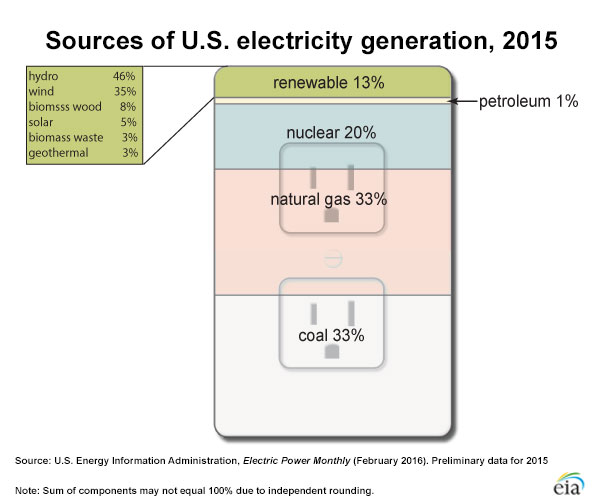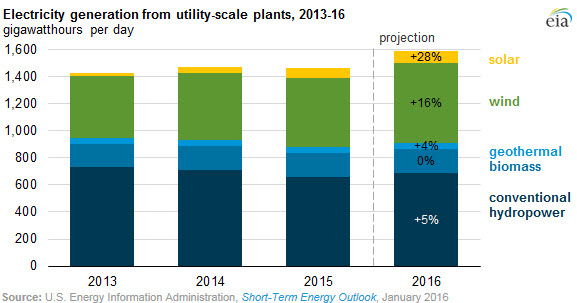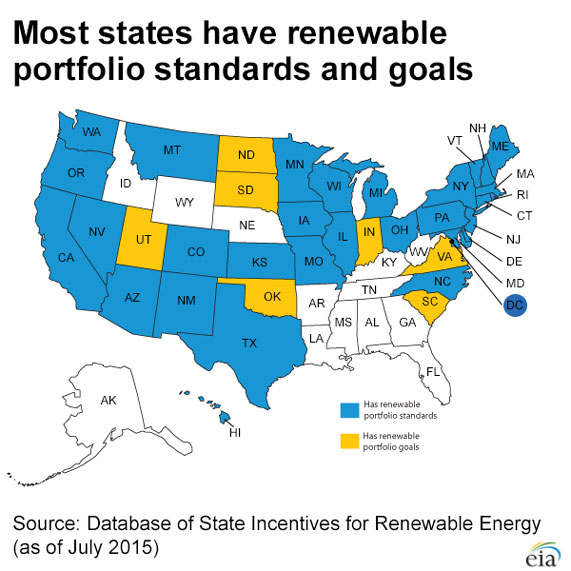Energy in Brief
How much U.S. electricity is generated from renewable energy?
Last Updated: May 5, 2016
U.S. power plants used renewable energy sources, including water, wind, biomass wood and waste, geothermal, and solar, to generate about 13% of the electricity produced in the United States during 2015.
Most electricity generated from renewable sources comes from hydropower
The largest share of electricity generated by renewable sources in 2015 came from hydroelectric power (46%), followed by wind (35%), biomass wood (8%), solar (5%), biomass waste (3%), and geothermal (3%). In 2015, for the second year in a row, solar, wind, and other nonhydro renewable energy sources combined to generate more electricity on an annual basis than the amount of electricity generated by hydropower.
The history of electricity generation provided by each renewable energy source in the United States is different. The generation capacity and availability of each resource has evolved over time.
- Almost all hydroelectric capacity was built before the mid-1970s, and much of it is located at dams operated by federal agencies.
- Biomass waste is mostly municipal solid waste or gases from landfills that are burned in waste-to-energy power plants.
- Most electricity generation from wood biomass occurs at lumber and paper mills. These facilities use wood waste to provide much of their own steam and electricity needs.
- The amount of electricity generated by wind has increased substantially in the past eight years. This increase is largely attributed to the construction of new wind turbines, which is encouraged by the availability of federal financial incentives and renewable portfolio standards (RPS) mandated by state governments.
- Solar generation almost tripled from 2013 to 2015. But unlike other sources of renewable electricity generation, a significant amount of solar generation growth has occurred with small-scale installations, often solar panels located on residential and commercial rooftops that in 2015 totaled 12.1 billion kilowatthours. EIA now includes estimates of small-scale distributed solar PV capacity and generation by state and sector in its Electric Power Monthly report.
- See related articles on renewable electricity at the state level—Today in Energy: April 22, 2016; February 5, 2016; November 4, 2015; September 1, 2015; August 14, 2015; June 29, 2015; and March 24, 2015.
The availability of renewable resources can vary
The amount of electricity generated by hydroelectric sources increases and decreases on an annual basis. This variation occurs primarily because of changes in rainfall and because of the amount of snowfall or melting snow in watersheds where hydroelectric dams are located. Like hydroelectric power, the amount of electricity generated from wind and solar resources can fluctuate as a result of daily and seasonal weather patterns. Electricity generation from biomass (wood and waste) and geothermal energy is relatively consistent because the availability of these resources is generally steady.
The United States is ranked second in the world in renewable electricity generation
China leads the world in the total amount of electricity generated from renewable sources, largely because of recent capacity additions provided by increased hydroelectric power generation. China is followed by the United States, Brazil, and Canada in the amount of electricity generated from renewable sources. Although China leads all nations in the total amount of electricity generated from renewable sources, the United States produces the most electricity from nonhydroelectric renewable sources.
Certain policies aim to increase renewable energy use
There are three types of government policies typically used in the United States to increase the use of renewable energy sources:
- Financial incentives. The Renewable Electricity Production Tax Credit, a federal incentive, encourages increased electricity generation from wind and other eligible renewable sources. States also offer financial incentives, such as grants, loans, rebates, and tax credits, to support renewable energy development.
- Targets. As of July 2015, 30 states and the District of Columbia had implemented enforceable RPS. These standards require electricity providers to generate, or purchase, a certain portion of their power supplies from renewable sources. Many RPS programs have escape clauses if renewable generation exceeds a specific cost threshold. Seven states have voluntary goals for boosting renewable energy generation as of July 2015. See related article—Portfolio Standards.
- Markets. Renewable Energy Certificates/Credits (RECs) allow residential consumers and businesses to purchase renewable electricity without the need for physical or contractual delivery of power generated from qualifying renewable energy sources. Detailed information on federal and state renewable energy policies is available using the Database of State Incentives for Renewables & Efficiency.
Learn More

Did you know?
Electricity generation from wind more than doubled from about 95 million megawatthours in 2010 to almost 191 million megawatthours in 2015. This increase was largely driven by improved turbine technologies, reduced cost of electricity production from wind, and government policies that encouraged the development of renewable energy sources.
Hydropower has historically been the dominant renewable energy source, but capacity in wind, solar, and other nonhydro renewable sources has increased so much in recent years that nonhydro renewable electricity generation exceeded hydropower generation for the second straight year in 2015. Lower-than-normal levels of rain and snow have also contributed to lower hydropower generation in recent years.




